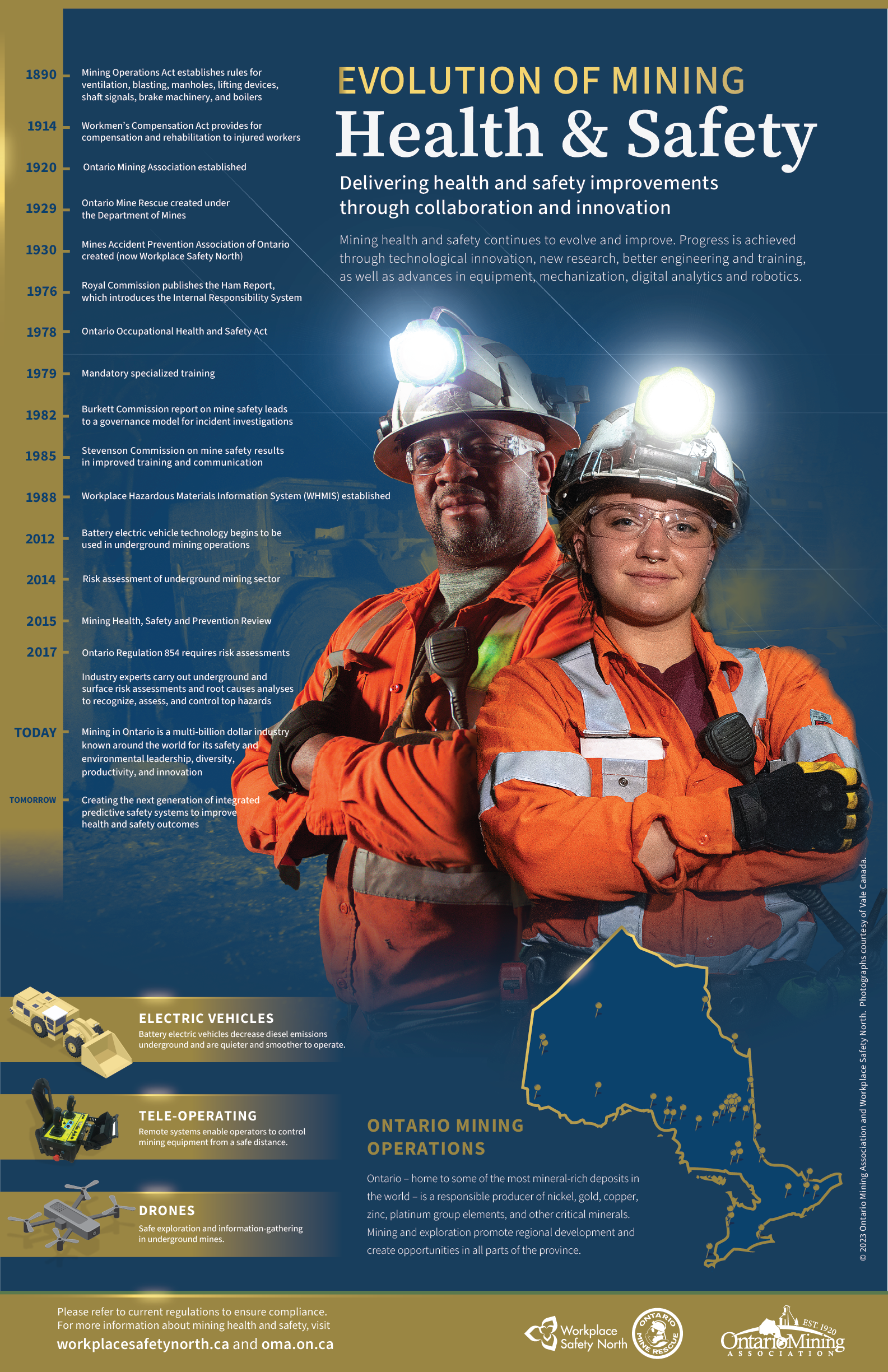Health and Safety
Ontario is one of the safest mining jurisdictions in the world and mining is one of the safest industries in Ontario. In the 35 years from 1975 to 2010, the Ontario mining industry achieved a 96% improvement in lost time injury frequency and, today, performs better than the Workplace Safety and Insurance Board (WSIB) industry average (public and private sector).
The Ontario Mining Association and its members collectively pursue zero harm in all business endeavours, seek to strengthen the Internal Responsibility System and to achieve reasonable, science-based legislation and regulation, which enhances employee safety and supports production.
Safe production is fundamental to Ontario mineral operations. The industry embraces the use of an integrated approach to the management of health, safety and the economic, technical and social processes of its businesses. The ultimate goal for any Ontario mining company is to achieve a zero-incident work environment. To that end, mining companies devote themselves to promoting an ingrained workplace safety culture by training employees, engaging in risk management, measuring performance, rewarding achievement, sharing information and adopting best practices. Frequent exposure to new information keeps mine workers focused on staying safe and healthy, while recognition programs for safety achievement, such as the John T. Ryan National Safety Trophy, strengthen company aspirations for continuous improvement.
The mining industry's health and safety culture often extends beyond the mine site. From funding healthcare facilities to partnering with non-governmental organizations to deliver education programs, or sponsoring community events, Ontario mining companies improve access to healthcare and information not just for their employees, but also for their families and the wider community.
The 'Evolution of Mining Health and Safety' infographic, released by OMA in collaboration with Workplace Safety North, highlights the significant milestones in Ontario mining health and safety since 1890, highlighting improvements in workers' personal protective equipment. Government, mining companies, and industry stakeholders continue to collaborate to ensure that mining operations in Ontario are conducted with the highest standards of health and safety, with the goal of protecting workers’ health. Progress is achieved through technological innovation, new research, better engineering and training, as well as advances in equipment, mechanization, digital analytics, and robotics.
Mining Health, Safety and Prevention Review
In 2014-2015, the Ontario government, in cooperation with the Ontario mining industry and labour, conducted a comprehensive underground mining health, safety and prevention review led by Ontario's Chief Prevention Officer (CPO). The review examined a number of topics to help ensure an even stronger and safer underground mining sector, with the CPO receiving expert advice and strategic input from an advisory group of industry, labour, and health and safety representatives.
The advisory group was established to ensure the public's and stakeholders' views were reflected in the review. A series of six working groups dedicated to important health and safety topics, as decided in consultation with our advisory group, explored ways to improve health and safety in the underground mining sector. These working groups were composed of participants representing labour and employers, supported, when necessary, by subject matter experts. Each group focused on the issues related to their specific topic and suggested ways forward to improve the health and safety for Ontario's underground miners.
The working groups reported to the CPO and the Advisory Group in early 2015. The valuable input of the working groups was considered by the Chief Prevention Officer with the advice of the Advisory Group in the drafting of the final report. As part of the review, the Ministry of Labour, Training and Skills Development held public consultations across Ontario and accepted written submissions between March and June 2014. Consultation feedback was considered by the Chief Prevention Officer, the advisory group and the working groups during the course of the review.
The final report contained 18 recommendations that are being implemented by the Ministry of Labour, Training and Skills Development and other health and safety system partners, including the Ontario Mining Association and Workplace Safety North.
The Mining Legislative Review Committee (MLRC) and its subcommittees, are key components of Ontario's ongoing improvement in mining health and safety. The MLRC, which is chaired by the provincial government and co-chaired by employer and labour representatives, advises the Minister of Labour on legislative and regulatory actions that will promote the health of workers and safe working conditions in Ontario mines. In addition to the MLRC, the development of company joint health and safety committees enable management and workers to address safety issues and procedures in the workplace.


.jpg)
